Would you believe me if I told you that for $30 you could score a legitimate 1,000+ lumen tactical flashlight with an included 18650 rechargeable battery?
In this Wowtac A7 review, I take a close look at one of the newest handheld lights that are marketed as suitable for tactical application.
Quick Takeaways
– compact and easy to carry
– appears to throw a lot of light
– somewhat cumbersome controls for tactical use
– risk of being burned if continuously used in the turbo mode
– can be purchased on Amazon for less than $30 – click here
Even though the features and specs were impressive, I spotted a significant problem immediately and discovered a potential burn hazard during testing.
So, will it serve your needs? It depends…
Let’s immediately dive into my review of this new flashlight.
General Information
The Wowtac A7 is a handheld flashlight with multiple light outputs. It uses a CREE XPL HI1 LED and is powered by a single 18650 battery.
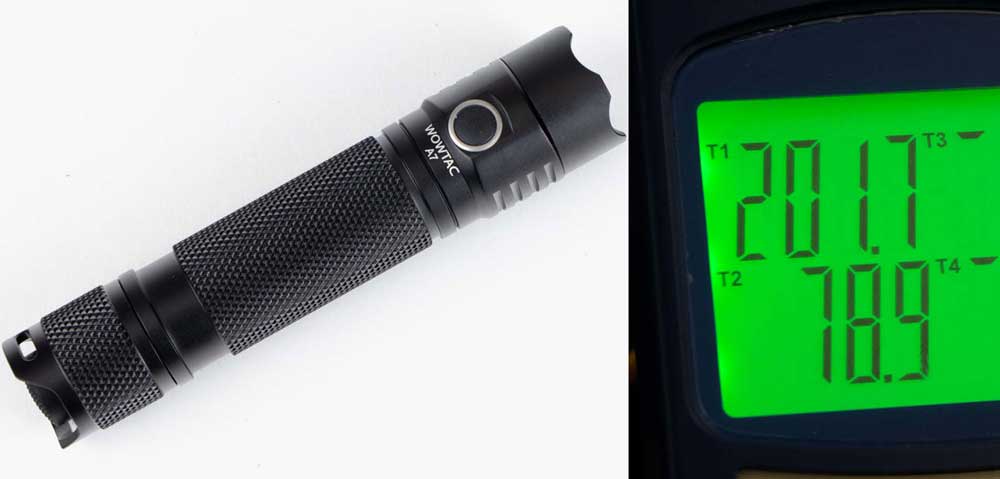
It has button-type switches on the tail cap and body. (Scroll down for more information on the controls.)
This flashlight fits easily in the hand and comes with a removable pocket clip for daily carry. The protective ears around the tail switch have slots where you can add a lanyard (not included).

Included with the flashlight are a single 18650 battery, USB charging cable and spare parts. It comes in a plain brown box similar to the company’s other flashlights.
A single-page, folded manual comes with the flashlight. Other than the specifications (listed below,) there is little detail in the manual.
Wowtac is a popular flashlight brand among portable lighting enthusiasts. Hobbyists tend to rate them highly and I’ve frequently seen people tout them on places like the /r/flashlight subreddit. My own experience with the company’s A1s was not good, so I hoped the A7 would offer better performance.

I’ve been concerned about the company’s portrayal of the lights as being suitable for tactical use. That marketing has a specific meaning for those of us who have relied on flashlights in deadly encounters. A soldier, armed citizen or police officer needs that light to work at the moment of truth to properly identify a threat and deal with it if needed.

Wowtac advertises the A7 as being a tactical flashlight that is suitable for “shoot-out preps,” security, hunting and other endeavors. Something seems to have been lost in the marketing translation, but the point is clear: this is a light that you are supposed to be able to rely on in a lethal force encounter.
So, it is in that context that this flashlight is reviewed.
Fair warning: If you’re only a flashlight hobbyist, you may not agree with all of my tests or conclusions…and that’s fine. We simply have different goals and expectations.
Controls & Output Modes
On the Wowtac A7, there are two switches: a tail cap clicky switch and a button on the body of the light near the head.
The switch on the tail cap activates the light. A half-press gives you momentary on while a full click turns the light on in a constant mode.
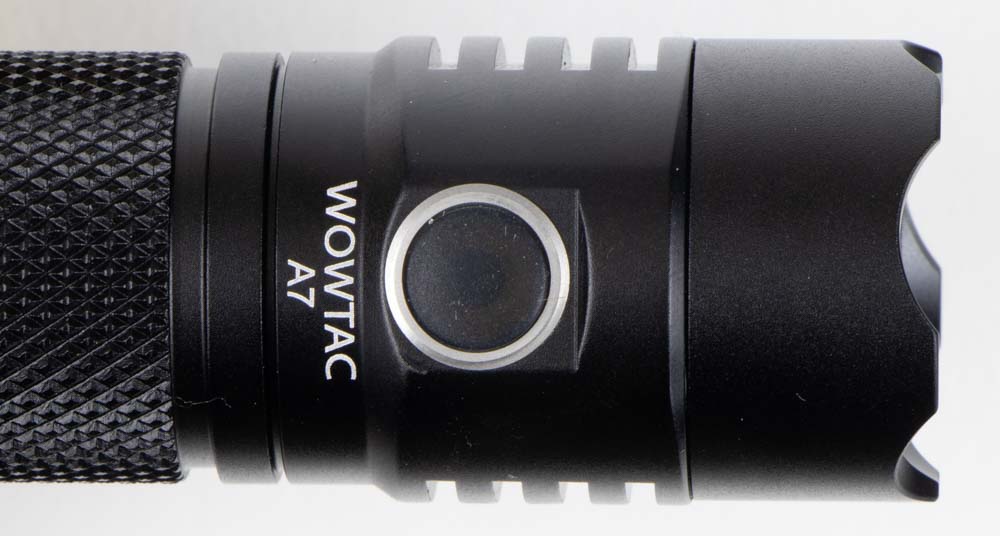
To control the various light level modes, you press the button on the body of the light. This cycles through all five of the constant modes. The light also has a strobe mode.
If you want to activate the Strobe mode, you have to first turn the light on. Then you have to press and hold the side button to enter strobe mode. To exit the Strobe mode, press the side button again and it will enter the Firefly (lowest output possible) mode.
The constant modes are rated from 0.5 lumens to more than 1,000 lumens. The strobe mode is only rated at 296 lumens.
| Firefly | Low | Medium | High | Turbo | Strobe | |
| output (lumens) | 0.5 | 12 | 65 | 296 | 1,047 | 296 |
| runtime | 108 days | 108 hours | 20 hours | 4 hours | 2 minutes* | 9 hours |
| beam distance | 268 m | 268 m | 268 m | 268 m | 268 m | 268 m |
| peak beam intensity (candelas) | 18,000 | 18,000 | 18,000 | 18,000 | 18,000 | 18,000 |
When you activate one of the light modes but later change the mode, the rotation starts off in the Firefly mode again. In other words, you cannot use the High mode and then decide to kick it up to Turbo mode because you need the extra light. You have to click through all of the modes to get to Turbo: Firefly, Low, Medium, High then Turbo. There are no known ways for you to re-program this.
There are no other controls to operate this Wowtac flashlight.
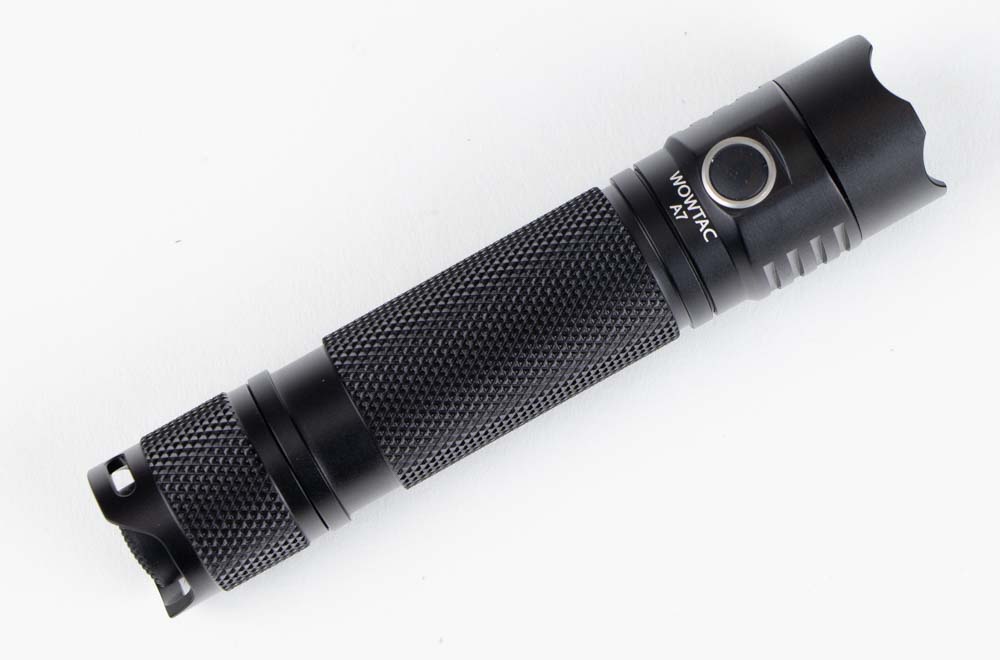
A few things are worth mentioning.
First, the company uses a step-down “feature” for the Turbo mode. After two minutes of operation in this mode, the flashlight drops its output to about 28% output. This 28% output appears to be equal to the “High” mode for this flashlight.
While you can return the light to the turbo mode manually every time it steps down, the company warns that running the light for more than 10 minutes in Turbo mode may damage the battery, controller and LED. (Scroll down to the heat generation section to see what happened when I ran it in turbo mode for more than two minutes.)
Secondly, the company lists the same peak beam intensity and beam distance for all of the levels as the same. While an 18,000-candelas measurement may be accurate in Turbo mode, I highly doubt the Firefly mode (0.5 lumens) has a beam distance of nearly 270 meters.
Please scroll down to read the Questionable Specifications and Testing sections below for additional information.
Battery & Charging
Included with the flashlight is a Wowtac branded 18650 rechargeable battery. It is rated at 3.6 volts and 2,600 mAh. While an included battery is nice, it has less storage potential than many of the 18650 batteries currently on the market including the 3,400 mAh battery Wowtac includes with the A1S flashlight.
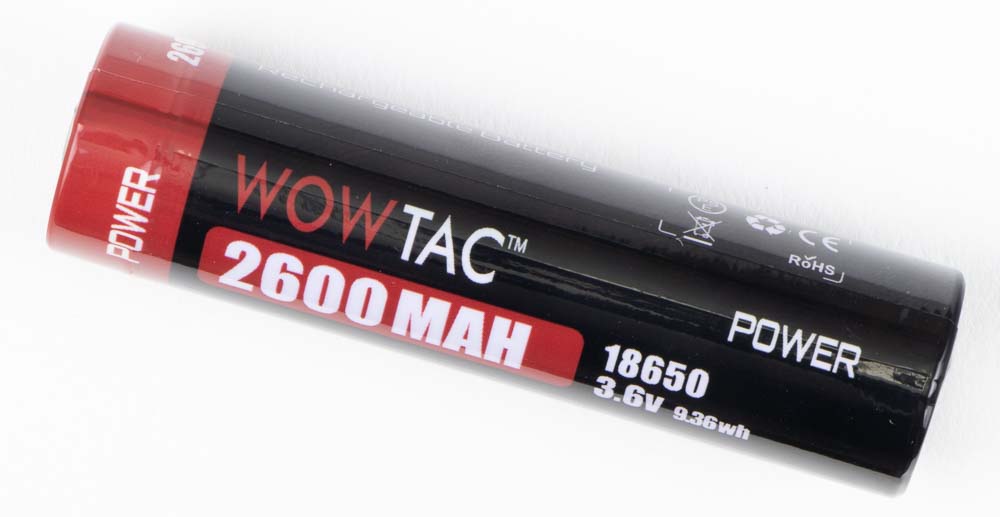
The light can use other brands of 18650 batteries, and I confirmed this with two other brands I had charging on my desk: a Streamlight 22101 and a Fenix ARB-L18-2900.
Wowtac designed this flashlight to charge the 18650 battery through an internal MicroUSB charging port. The company includes a short USB to MicroUSB cable but no power converter (wall plug).
The Wowtac A7 does not charge like some other devices. With many electronics, you simply plug the device in and it begins charging. With the Wowtac A7, you have to click the tailswitch so that the flashlight is in the constant on position. Only then do you plug it in to charge the battery.
When the flashlight is charging, a dim red light will glow around the head switch. When it is fully charged, the light turns blue. If, however, there is a problem with the charging the color will turn purple.
As a test, I tried charging the light without first turning on the flashlight. Sure enough, the light glowed purple and it did not charge the battery at all.
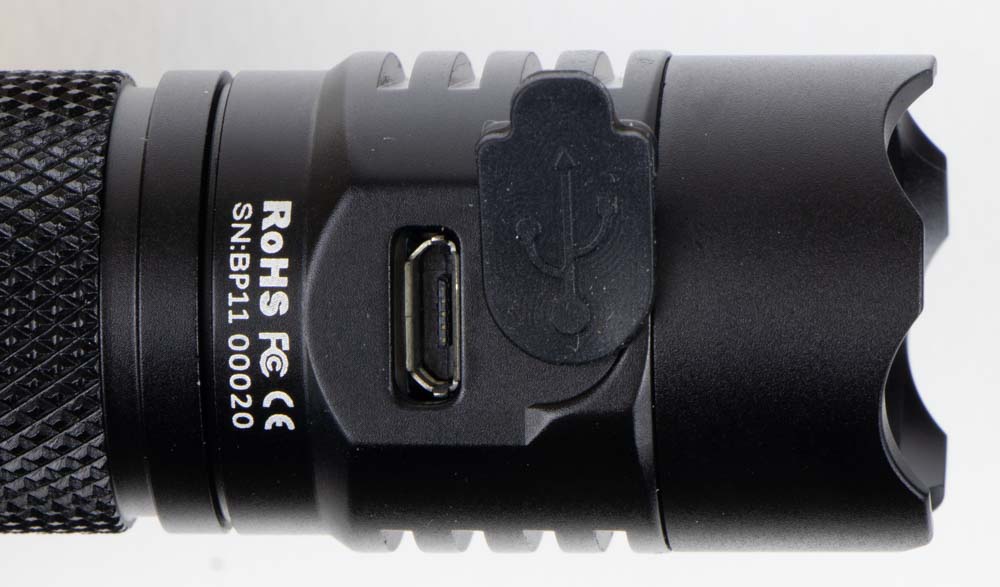
I found that charging the batteries in a third-party caddy charger also works fine. However, for all runtime and output testing, I only used the included USB cable to ensure it was charged exactly as Wowtac intended.
To access the charging port, there is a thin rubber-like flap that has to be moved out of the way. The flap feels flimsy and appears that it would be easy to damage. I’ve experienced durability problems with similar flaps on other flashlights like the Fenix LD15R. Fortunately, Wowtac includes a spare in case the original goes wrong.
Questionable Specifications
Here are the specifications as indicated by Wowtac. However, I have doubts about the accuracy of the information they report. (See also the table in the Light Output Modes above.) More on that in just a minute.
| LED | CREE XPL-HI |
| working voltage | 2.7-4.2v |
| weight (manufacturer reported) | 3.7 oz |
| length | 4.6″ |
| impact resistance | 1.5 m* |
| water resistance | IPx8 (2 m for 4 hours) |
| MSRP | $29.99 |
* Per ANSI/NEMA FL1 (2009) standards, all impact resistance heights are to be rounded down to the nearest whole number.
One of the problems in the flashlight industry is the testing standards, and I feel the Wowtac specifications highlight this problem.
The company claims to adhere to the deprecated (outdated) ANSI/NEMA FL1 (2009) standard. That standard has been revised twice since its original publication.
Wowtac confirmed by email that the flashlight was tested to the outdated standard, but provided no reason for having done so.
I’ve seen other companies use the deprecated standard for recently produced flashlights as well. A cynical person might suggest that a company would choose an unenforceable standard to avoid recourse if it exaggerated the flashlight’s performance.
I’m not saying Wowtac lied about the A7 specifications, but I suspect there are other companies that have.
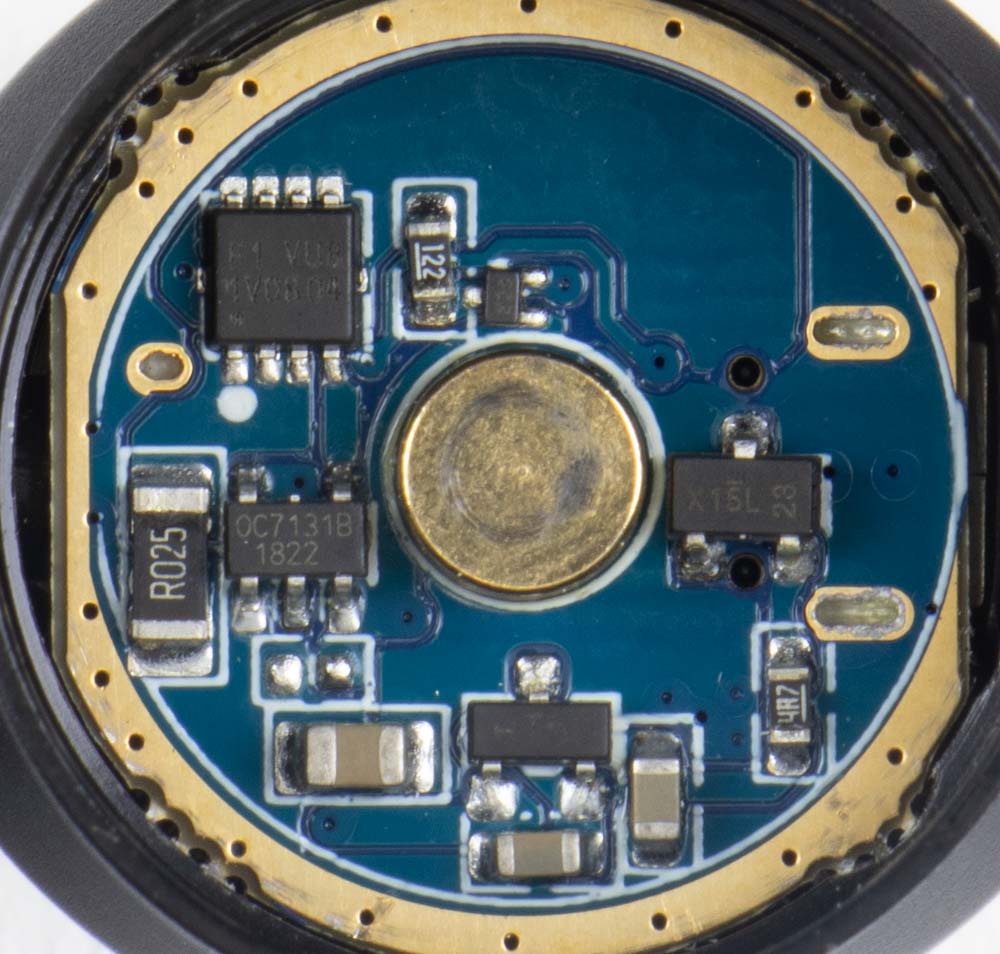
To compound the problem, the current organization that maintains the FL1 standard – the Portable Lights American Trade Organization (PLATO) – charges hundreds of dollars for each copy of the standard. This creates a barrier for the average consumer to see what the standard actually tests.
It seems to me that the “self-regulating industry” doesn’t want consumers to fully understand the specifications. You can read more about the problems I see with the FL1 standard and PLATO on my Flashlight Reviews page.
Making matters even worse for consumers, testing flashlights to the FL1 standard is expensive. Scientific equipment like calibrated integrating spheres are needed and can cost thousands of dollars. That’s one of the many reasons why you don’t see many fact-based reviews of flashlights anywhere. Most are merely opinions on how bright something seems to be.
Be sure to scroll down to my testing section for more on this.
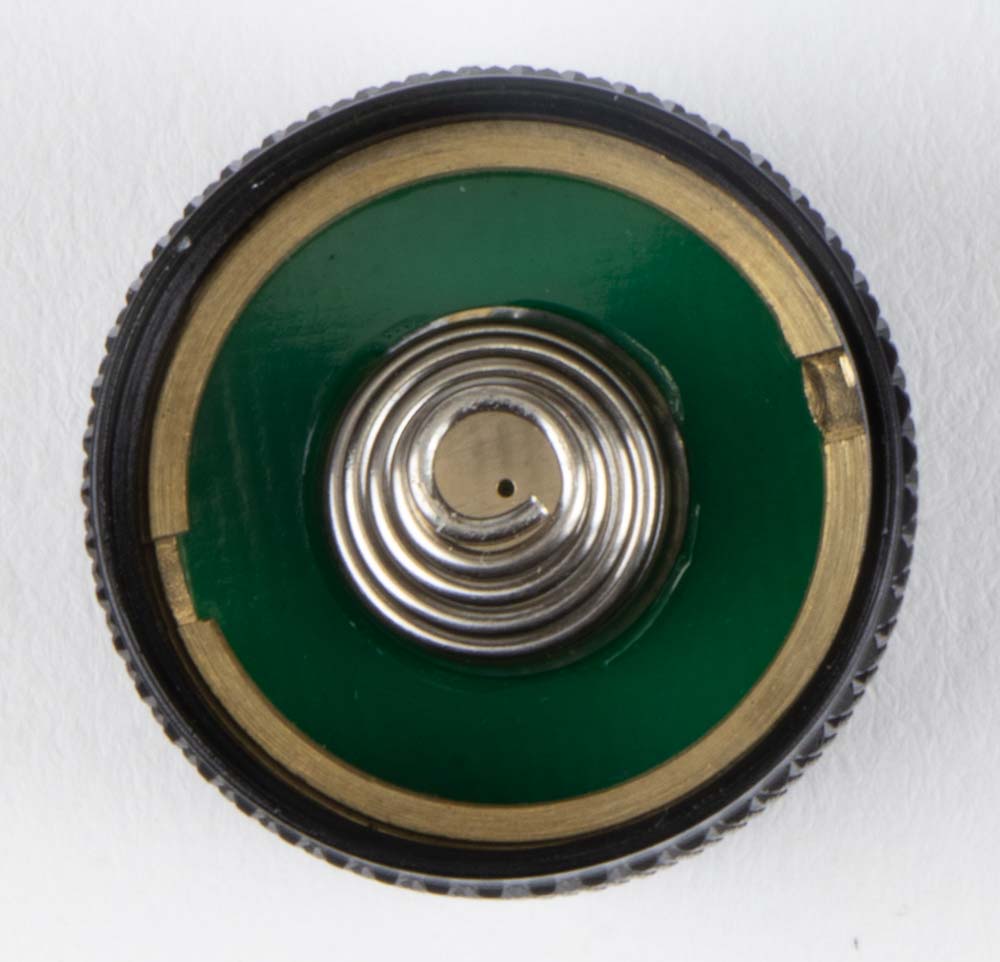
When I examined the A7, I immediately spotted that the Wowtac specs were not in compliance with either the FL1 (2009) standard.
Specifically, the FL1 (2009) standard on page 10, under section 2.6.6 Impact Resistance Rating states:
Ratings in excess of 1 m shall be reported with values rounded down to the nearest whole number.
That means if Wowtac was following the FL1 (2009) standard, it would report its impact resistance as 1 m. Since it did not, I am suspicious of all of the A7 specifications.
Testing
I’ve developed my own set of testing protocols that are influenced by the FL1 standard. I’ve developed a set of tests that I feel are good for describing the various characteristics of a tactical flashlight.
Keep in mind – I am testing this as a tactical flashlight, not a hobbyist’s toy.
I test flashlights for the following things:
- total light output over time
- heat generation
- visual comparison of the light at a known distance
- impact resistance
- water resistance
- daily carry
Here we go…
Output Over Time
Output over time is a commonly misunderstood specification…and one that many flashlight makers happily take advantage of.
According to the FL1 standard, a manufacturer can report the total time it takes a flashlight to run down from the initial output to a mere 10% of the original light output. This number is not how long the flashlight will put out its rated output (lumens.)
When a consumer looks at a package and sees 500 lumens and a one-hour runtime, they will often think the flashlight will throw 500 lumens for one hour. In actuality, it may be the light throws 500 lumens for two minutes then outputs a mere 55 lumens for the next 58 minutes. The consumer’s misunderstanding is to the flashlight industry’s benefit.
I test all flashlights in a homemade illuminating sphere. I do not test for absolute lumen output, and no one can do so to any reasonable degree of accuracy without having a calibrated system.
Instead, I measure the output over the runtime of the light expressed as a percentage of the initial output. So, if a flashlight puts out X light initially and then dips output to 20% of X to maximize its runtime number, you will see that.
Turbo Mode
Turbo mode is the highest output available for the Wowtac A7.
The company has a built-in step-down at the two-minute mark likely due to the excessive heat it generates. (Scroll down to the heat generation section below to see what I mean my excessive.)
Below is the graph showing the Turbo mode output. You can click on it for a larger view.
As you can see, the light output drops more than 70% at the two-minute mark. This equates to about the same light output as the High power mode.
Once the light drops to about 28% of the initial output, the run time to 10% is 3 hours 4 minutes. This is about an hour short of the stated runtime of 2 minutes at the initial output and 4 hours of the reduced rating. If you were to make a trendline of the measured output, it appears that it would dip below 10% between 3:30 and 3:45 – closer to the stated runtime.
I decided to test the flashlight in continuous Turbo mode to see what kind of runtime regular use of that mode might yield.
With the flashlight programmed to automatically drop in power at every two minutes, I set a timer for 1.75 minutes. Each time the timer buzzed, I cycled the light through the modes to reset it back on Turbo. Wowtac recommends running the light in this manner for no more than 10 minutes. For reasons I discuss below, I recommend against ever doing it.
Note: I ran this test last. If the light suffered any problems, I wanted to make sure I recorded its performance in the recommended output modes first.
Below is the graph of the light output:
At the end of 10 minutes, the total light output was still respectable at about 80% of the initial output. Respectable output levels were maintained beyond 45 minutes, with the light hitting the 50% mark at 50 minutes and the 10% mark at 56 minutes. With a higher capacity battery, the 50% runtime could stretch beyond one hour.
The problem with running the light in continuous Turbo is the amount of heat it generates. Additional information on the extreme heat generation is discussed below.
High Mode
I ran another test of the light in just High mode. The results are below:
The High mode meets my expectations based on the company’s runtime specification of 4 hours.
While I think the FL1 runtime specification is not a fair representation of a flashlight’s performance, the Wowtac A7 kept its average light output above 50% (roughly 150 lumens) for about two hours which isn’t bad if that level of light is acceptable for your needs.
I decided to run the High mode test again using the Wowtac 3.6v 3,400 mAh 18650 to see what runtime could be expected with a higher capacity battery. That chart is below:
The 3,400 mAh battery extended the runtime to a little more than 5 hours before output dropped below 10%. The trendline for light output stayed above 10% a little longer.
Additional Thoughts
While the runtime graphs look acceptable compared to many similar flashlights, keep in mind that they represent an output of less than 300 lumens for the vast majority of their use.
If you are looking for continuous 1,000 lumens of output for more than 2 minutes the Wowtac A7 does not seem like it will deliver. If you try to get 1,000 lumens for a longer period of time by cycling the light on and off – you’ll quickly run into problems that I illustrate in the heat generation section.
Measured Candelas
This is a straightforward measurement that is calculated from measured lux at a specific distance. This is what I measured:
| Firefly | Low | Medium | High | Turbo | |
| Manufacturer Specs | |||||
| peak beam intensity (candelas) | 18,000 | 18,000 | 18,000 | 18,000 | 18,000 |
| beam distance | 268 m | 268 m | 268 m | 268 m | 268 m |
| Measured | |||||
| peak beam intensity (candelas) | 8 | 442 | 1,479 | 5,788 | 20,030 |
| beam distance | 5 m | 42 m | 77 m | 152 m | 283 m |
Heat Generation
Many high output flashlights drive their emitters hard and generate copious amounts of heat. Nearly all high output lights will reach a surface temperature that makes them uncomfortable to hold.
With some flashlights, the surface temperature can reach the point of causing minor hand burns. Unfortunately, that seems to be a concern with the Wowtac A7 flashlight.
Below is the graph of the heat generated by the Wowtac A7 during its full run in Turbo mode. Keep in mind that Turbo mode has the automatic step down in output at two minutes and you can see that small hiccup in the initial ramp-up in heat.
Notice the nearly vertical line of temperature increase while the flashlight was operating in the Turbo mode. As soon as the step-down happened, you can see the temperature drop and then moderately increase over time. The temp did not exceed 120° F in this test.
While the temperatures may be too hot for some people to hold comfortably, this heat level should not be dangerous.
I ran the test in a continuous Turbo mode as described in the output over time section above. These are the results I measured:
During that run, the surface temperature of the flashlight reached 188.4° F. At the time of testing, that was the third-highest temperature I had ever recorded.
However, I ran into a small issue during testing that may have affected the temperatures. During the testing, an exterior door was opened twice allowing winter air to enter my work studio. The air temperatures outside were about 45° F – about 30° F cooler than the ambient air in the testing area. You can see the drops in the measured temperatures at the 16 minute and 21-minute marks that coincided with the cooler air washing through my testing area.
A second test in the continuous turbo mode showed a rise in temperatures that were unabated through 30+ minutes. The results were stunning:
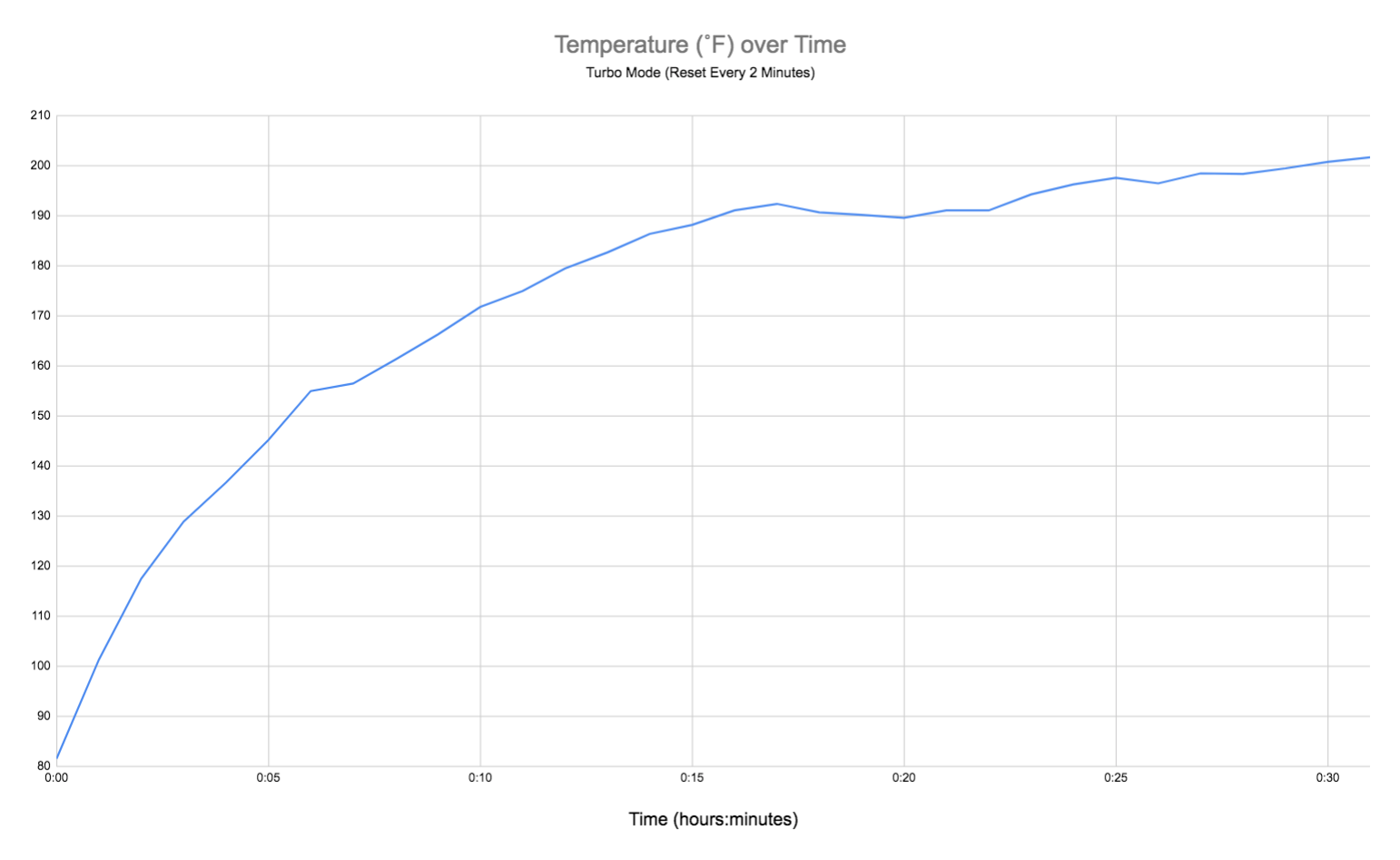
In this run, the surface temperature of the flashlight reached 201.7° F before I discontinued the test for safety reasons. A burning smell began to issue from the flashlight, so I stopped the testing for fear of a battery fire or explosion. This is the second hottest flashlight temperature I have ever recorded. The hottest temperature I’ve recorded was the Olight S30R Baton III at 203.3° F.
Nowhere in the Wowtac manual or on the Amazon sales page are there any warnings about burns or heat from this flashlight. The only warning the company offers regarding running the light for longer than 10 minutes in the Turbo mode is that it may damage the internal components of the flashlight.
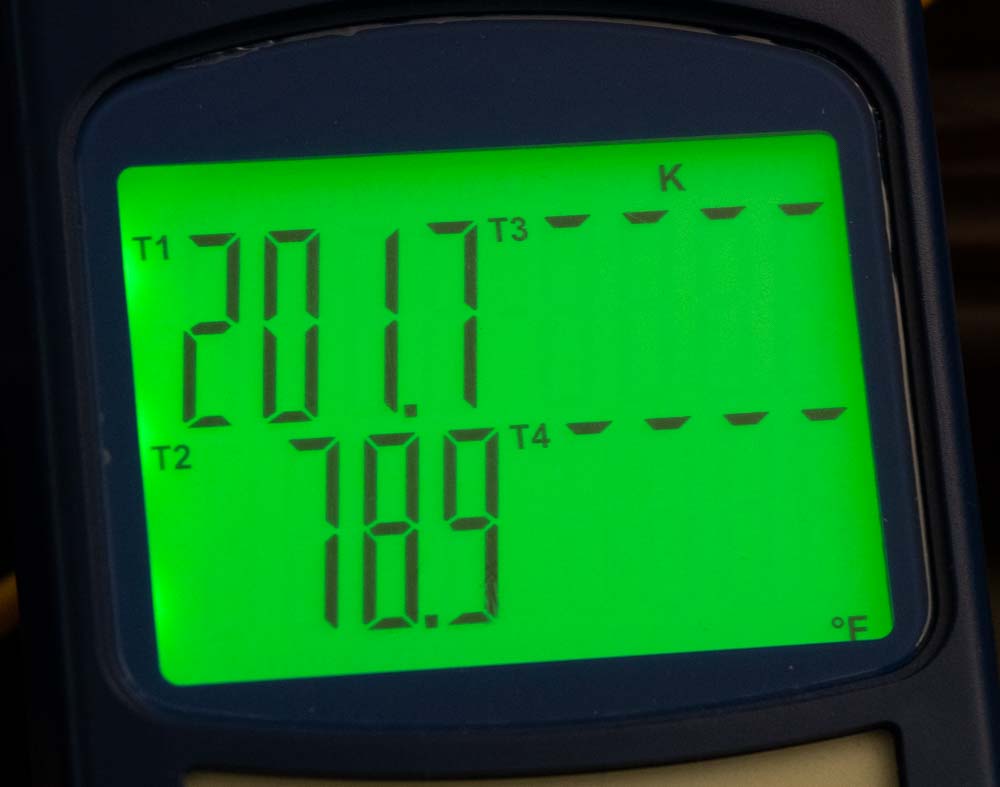
According to research by A. R. Moritz MD and F.C. Henriques Jr PhD (The Relative Importance of Time and Surface Temperature in the Causation of Cutaneous Burns), a two-second exposure to 60° C (~140° F) can result in burns (focal epidermal necrosis) while a five-second exposure can result in severe burns (complete epidermal necrosis.) At 70° C (~158° F), a one-second exposure can result in complete epidermal necrosis.
In just 10 minutes – a time that is acceptable to run the flashlight in Turbo mode according to Wowtac – the surface temperature soared to 169.7° F (~76.5° C) on the first test and 171.8° F (~77° C) in the second. According to the medical research that I’ve read, those temperatures could cause burns.
In my opinion, the excessive heat generation created by this flashlight is unacceptable and dangerous.
Note: I ran the continuous turbo modes after testing all of the other modes.
Testing the A7 in the High mode, I recorded the temperature over time for it as well. That graph is below.
In this run, the temps exceeded 120° F but still stayed below dangerous levels. I would expect that this amount of heat would not be a problem for most people when wearing gloves.
Since I did a run test of the A7 in High mode with the Wowtac 3,400 mAh 18650 battery, I recorded the following temperature data also.
The peak temperature was very similar to that of the flashlight when running with the lower capacity battery.
Visual Comparison
Although photos can be very misleading, I know a lot of readers like seeing images of the flashlight’s power at night.
The below images are comparison shots. You can move the slider left and right to see what each of the photos looks like.
All of the camera settings remained the same throughout the testing.
This first pair of photos shows ambient light only (left image) and the Wowtac A7 in Turbo mode. The distance was 9 yards.


As you can see, the light has a bright spot beam with reasonable falloff to illuminate the surrounding area.
In the below photo, you can see the A7 in Turbo mode (left) and the Wowtac A1S in Turbo mode (right).


You can see that the A1S throws more light than the A7 with the same model 18650 battery. The center beam is wider, though it appears to be about the same brightness. There is more falloff also, meaning better periphery light to see what else is moving beyond the subject of your flashlight’s focus.
I compared the Wowtac A1S to some other flashlights. First up is the SureFire G2X.
I recently wrote a SureFire G2X review and found that I liked the flashlight very much. In fact, it has become my daily carry light for any time I have some reasonable expectation of being out after dark. It is not rated for nearly as much light output – just 600 lumens and 8,700 candela- as the A7, but it is still very bright.
Below is the A7 (left) and the SureFire (right):


The specs suggested it and the photos seem to confirm it: the Wowtac is brighter. While that’s not the only characteristic of a flashlight you should be concerned with, it is a major one.
I also decided to compare the A7 to the similarly spec’d Fenix PD35 flashlight. The PD35 is rated at 1,000 lumens and 10k candela. This suggests that the total light output should be similar between the lights, but the A7 should have a tighter beam pattern.
In the below comparison, the A7 is on the left and the PD35 is on the right.


To my eye, there is little difference between the two for center brightness. However, the PD35 seems to have a slight bit more periphery light.
Drop Test & Water Resistance
Impact resistance is measured in meters.
Wowtac lists the impact resistance at 1.5 meters. As I explain above, if the company adhered to the FL 1 standard, this number would be rounded down to the closest integer – 1 meter in this case.
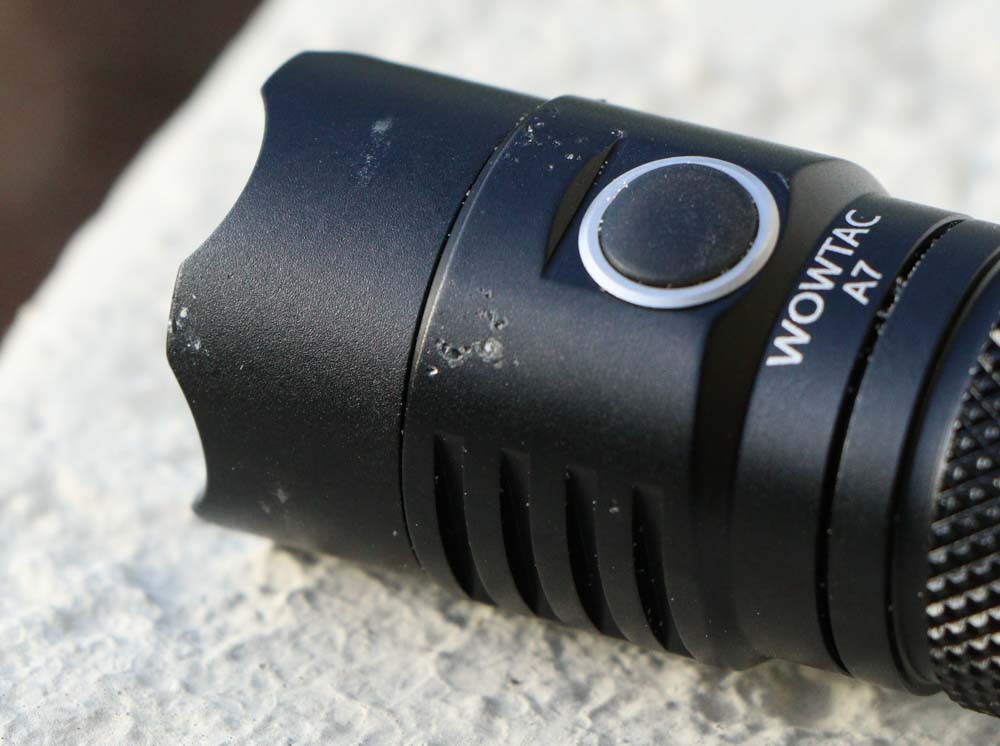
For my drop testing, imagine the flashlight as a cube. I drop the flashlight six times – one on each “side” – onto cured concrete. I then check to see if the flashlight stops working or suffers significant damage that would impair its use.
Each drop of the Wowtac flashlight scarred the unit, but I found no significant structural problems. Additionally, the light continued to work normally.
Wowtac claims an IPX8 water resistance. For this flashlight that means it is submersible to a depth of 2 meters for up to four hours. My pool is only 1.8 meters (6′) deep, so I tested the light at that depth for four hours.
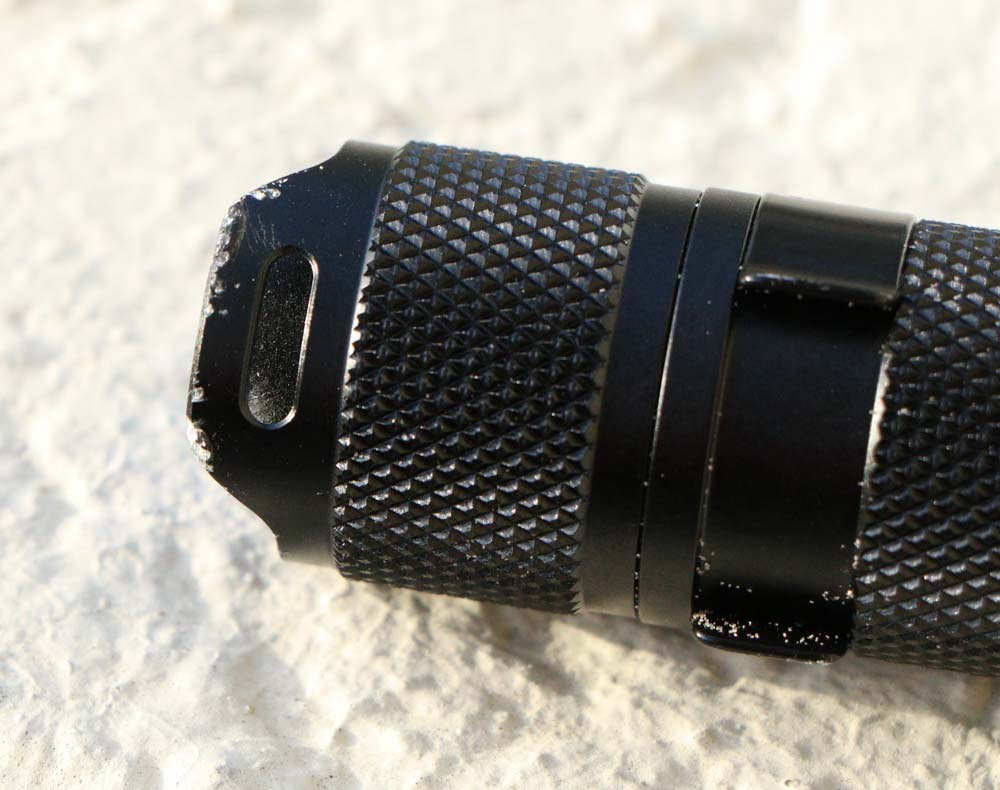
The charging flap and single O-ring construction kept water out of the light.
I would urge caution about relying on the flashlight to be waterproof. If you are carrying the light, it is possible for the flap to be slightly dislodged. If it is not sealed, water could intrude into the charging area of the light and possibly damage it.
Daily Use and Carry
I carried the Wowtac A7 for three weeks as my daily carry flashlight. This means it road in my left front jeans pocket every day, and I used it as a primary flashlight for almost every task.
The Good
The A7 was light and relatively thin. It did not get in my way and took up less space than my normal daily carry – the SureFire G2X. (For more information on that light, read my SureFire G2X review.) Also compared to the SureFire, the A7 seemed brighter with a whiter light.
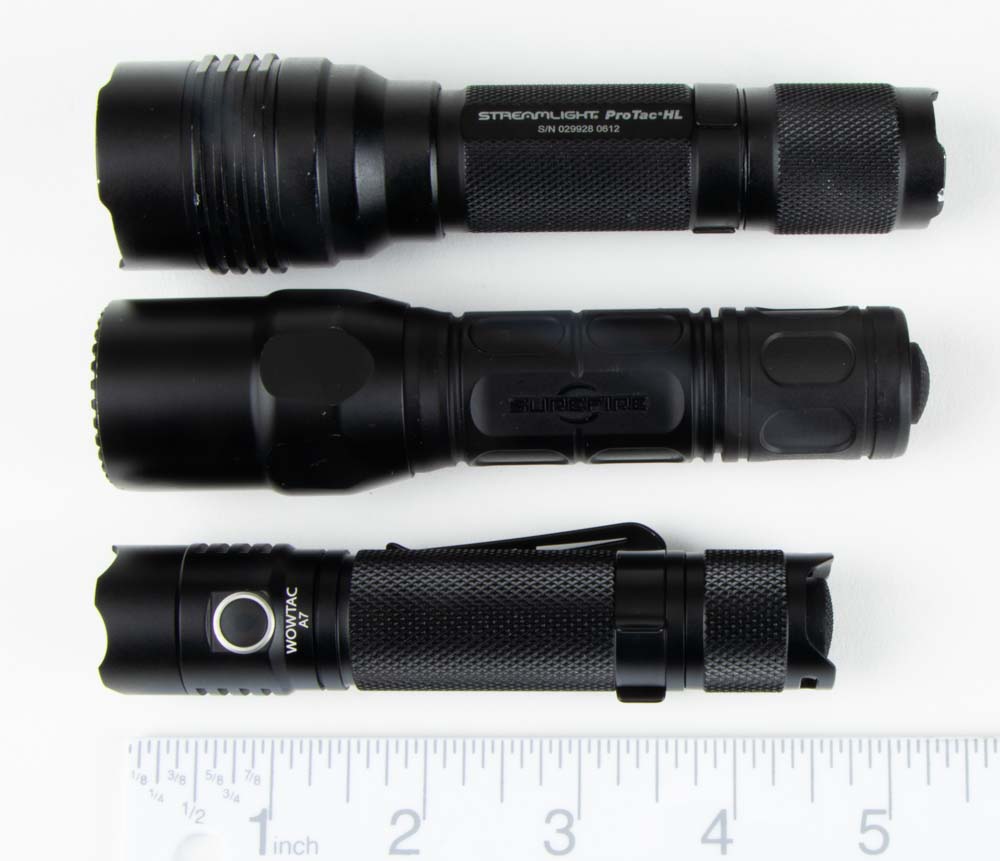
I had good service from the pocket clip. It held the flashlight in place and did not snap off unexpectedly.
With intermittent use, the Wowtac A7 seemed to have a good amount of use between charges.
The Bad
I found the tailcap switch to be difficult to use in comparison to other brands such as SureFire, Streamlight and Fenix. All of those lights have switches that allow for easy activation of both the momentary feature and the full click for constant on.
I found that I had to use the tip of my thumb for complete control of the light. If I tried to use the pad of my thumb, it became more difficult to activate the light in a controlled manner.
Likewise, the protective ears on the tailcap protrude up far enough to completely prohibit the activation of the switch with the pad of your thumb if they are aligned with your thumb.
Even when you use the end of your thumb, the resistance by the switch seemed unnecessarily hard.
Wowtac A7 vs Wowtac A1S
One of the obvious comparisons that some people will make is between the Wowtac A7 and A1S flashlight models. How do they really measure up?
The two lights are similar, but there are some significant differences. The most obvious is in length with the newer A7 being about 0.8″ shorter than the older A1S.
The rated output – both lumens and candela – of the A1S is slightly more than the A7: less than a 10% for both measurements.
Interestingly, Wowtac included a 3,400 mAh 3.6v 18650 battery with the A1S, but only a 2,600 mAh 3.6v 18650 with the A7. The increased battery capacity gave longer run times to the A1S.
From a tactical viewpoint, the A7 is a superior choice because of the improved side button. I found the taller mode button on the A1S was too easy to accidentally press. In a self-defense situation, you do not want the light to drop from turbo or strobe modes to low.
Final Thoughts
For an inexpensive flashlight, the Wowtac A7 may be the budget-friendly light you need. However, it has some flaws that prevent me in recommending it as a tactical flashlight.
The light’s various modes are complicated under the stress of a deadly force encounter, the tail switch isn’t as responsive as alternatives and the charging port cover isn’t likely to survive long-term use.
Further, if you are in a deadly force situation, you may need to run the light in turbo mode for more than 2 minutes. With this light, you can choose to drop more than 70% of its light output or run the risk of the flashlight becoming too hot to hold.
Its potential for dangerous heat generation – even when using it according to the Wowtac A7 manual – is unforgivable to me. This light seems to push the envelope of light generation and can become dangerous in specific situations.
I encourage Wowtac to put a thermal sensor in the light to throttle output to prevent potential burn injuries.
While not directly related to its tested performance, I particularly don’t like the fact that Wowtac’s reporting of specifications is…unclear…as I described above.
However, the A7 is still a reasonable flashlight light for anyone not wanting to spend more than $30.
It appears to throw about 1,000 lumens with a tight beam that can help identify a potential threat across the yard or in a parking lot. While I would prefer a wider beam for interior use, the A7 provides an adequate amount of spill for room clearing.
For your $30, you also get a 18650 battery that can be charged via USB in the flashlight or on a third-party charger.
If you otherwise like the operation of the light, it may adequately serve you as a budget-friendly tactical light.
If you’re just looking for a bright light as a hobbyist, go ahead and get one of these. There’s nothing wrong with the light as a knock-around truck light or a fun addition to your flashlight collection.
Where to Purchase the Wowtac A7
Disclosures
Anyone producing product reviews should provide a full disclosure of any potential biases that may influence their testing and reporting. If they do not, you should ask them why.
The A7 flashlight was provided to me for review by Wowtac. The flashlight was shipped from Amazon, so I don’t believe it was a hand-picked light. However, I cannot guarantee that.
Wowtac did not ask for a positive review of the light or place any conditions on how I reviewed the light. I’ve previously reviewed the Wowtac A1S, a light I purchased with my money.
I have no financial interest in Wowtac or any other lighting company. No monies or other forms of remuneration were offered or given for this review.
GunsHolstersAndGear.com is a for-profit website. I do not charge readers a dime to access the information I provide.
Some of the links on this page and site are affiliate links to companies like Amazon and Palmetto State Armory. These links take you to the products mentioned in the article. Should you decide to purchase something from one of those companies, I make a small commission.
The links do not change your purchase price. I do not get to see what any individual purchases.
If you have any questions about any of this, please ask in the comments section below. Please keep all comments civil and free of profanity. This is a family-friendly website.
Thank you for your continued support!
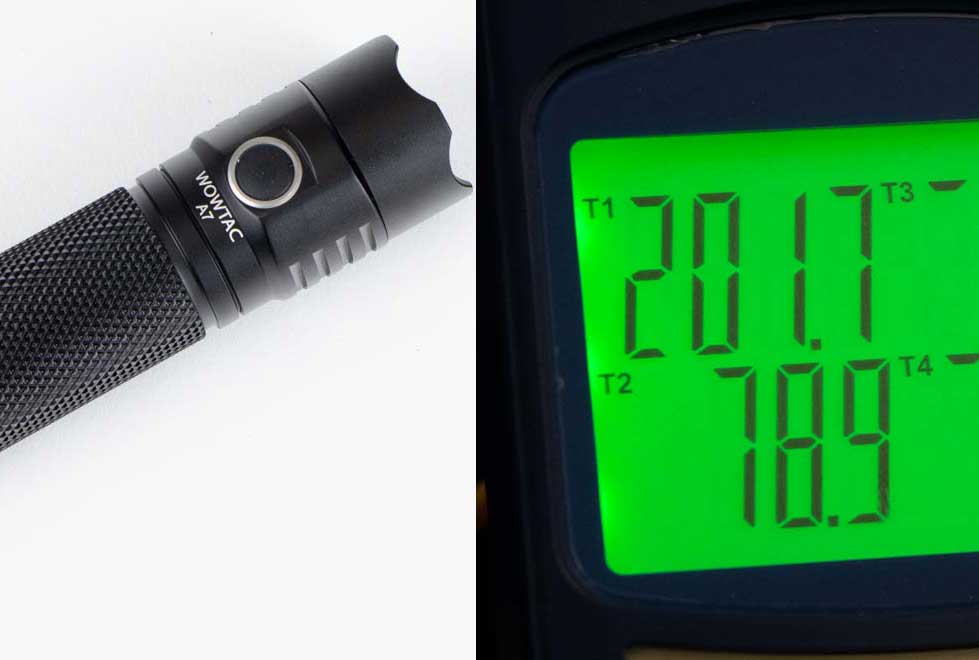

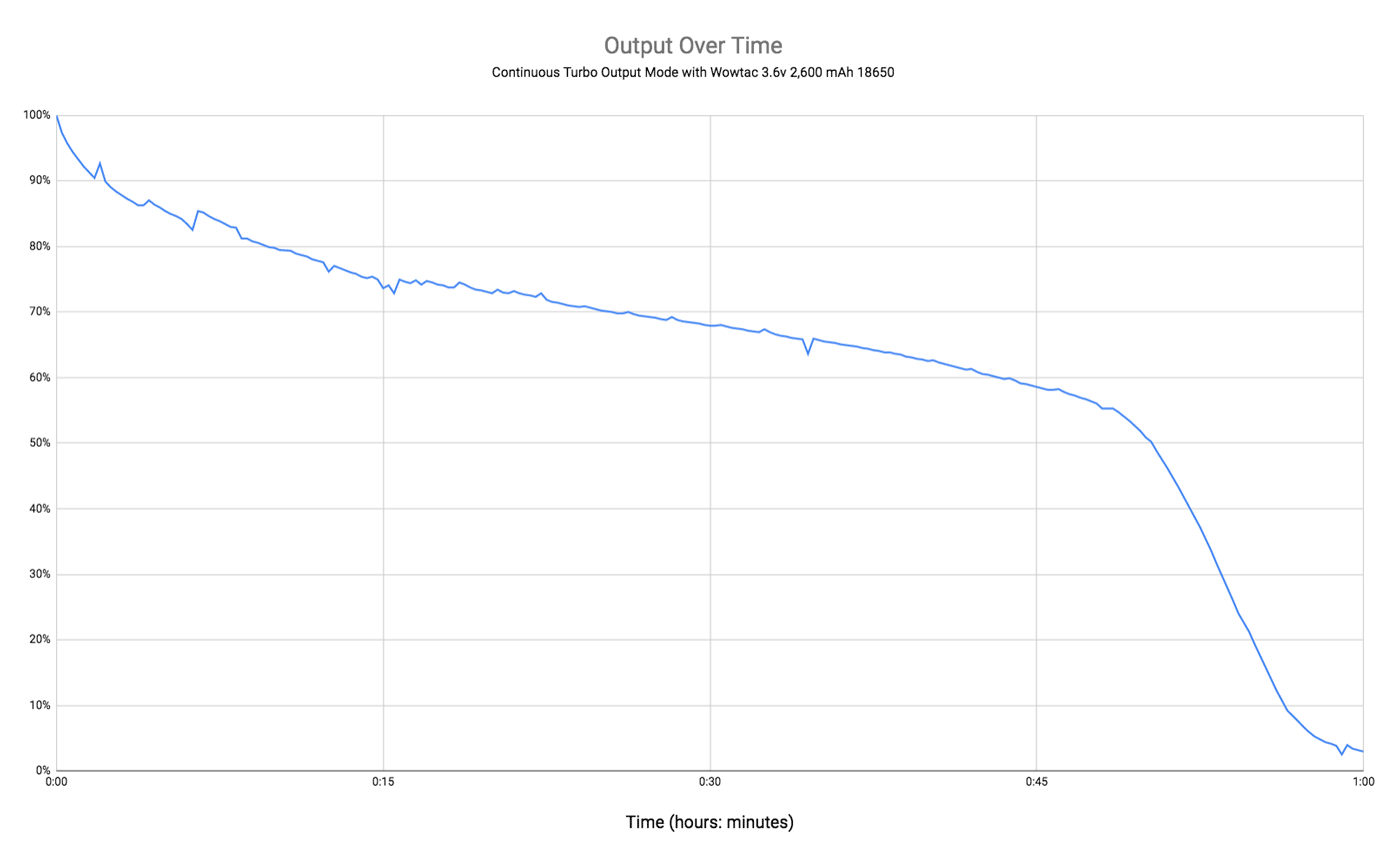
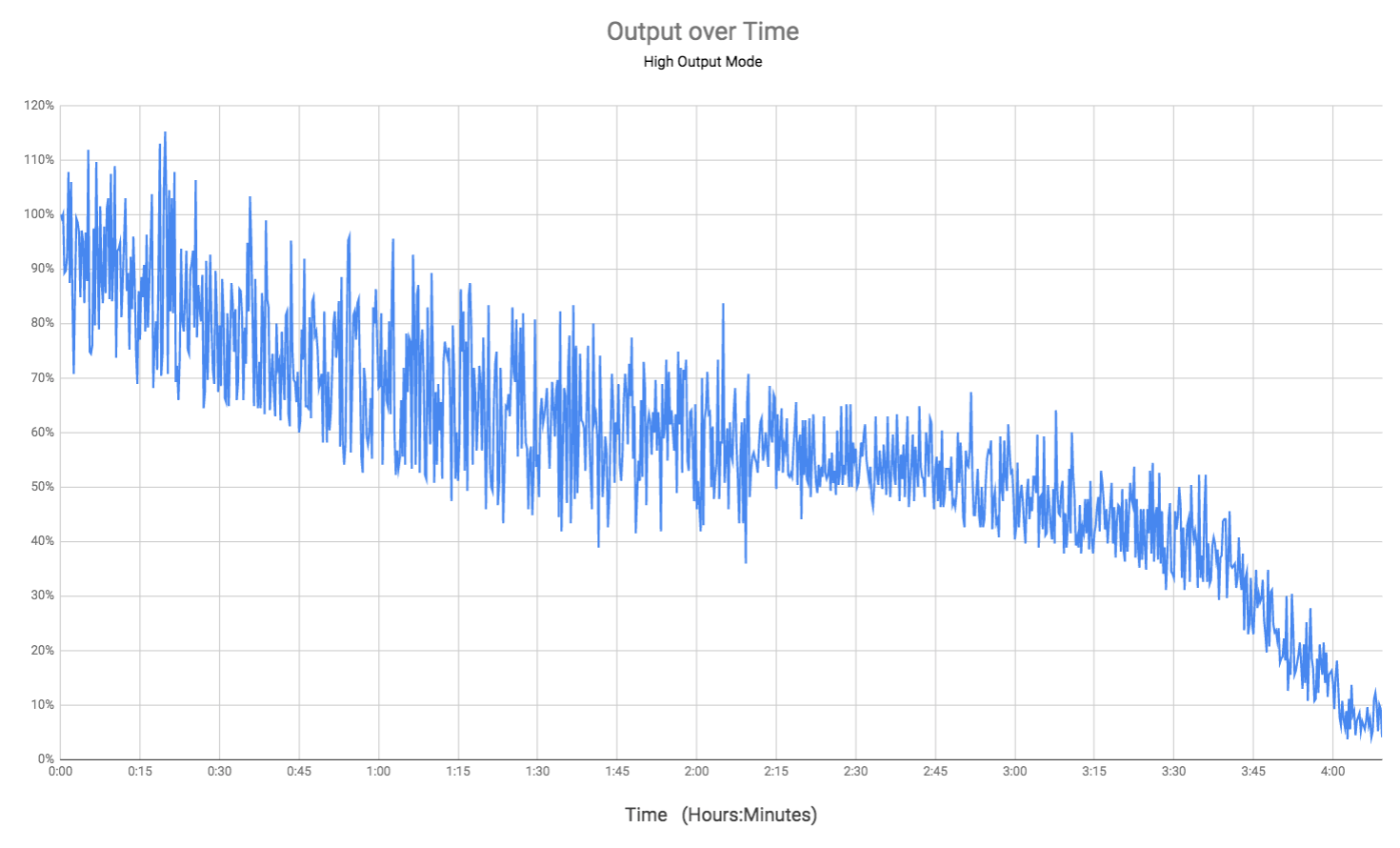
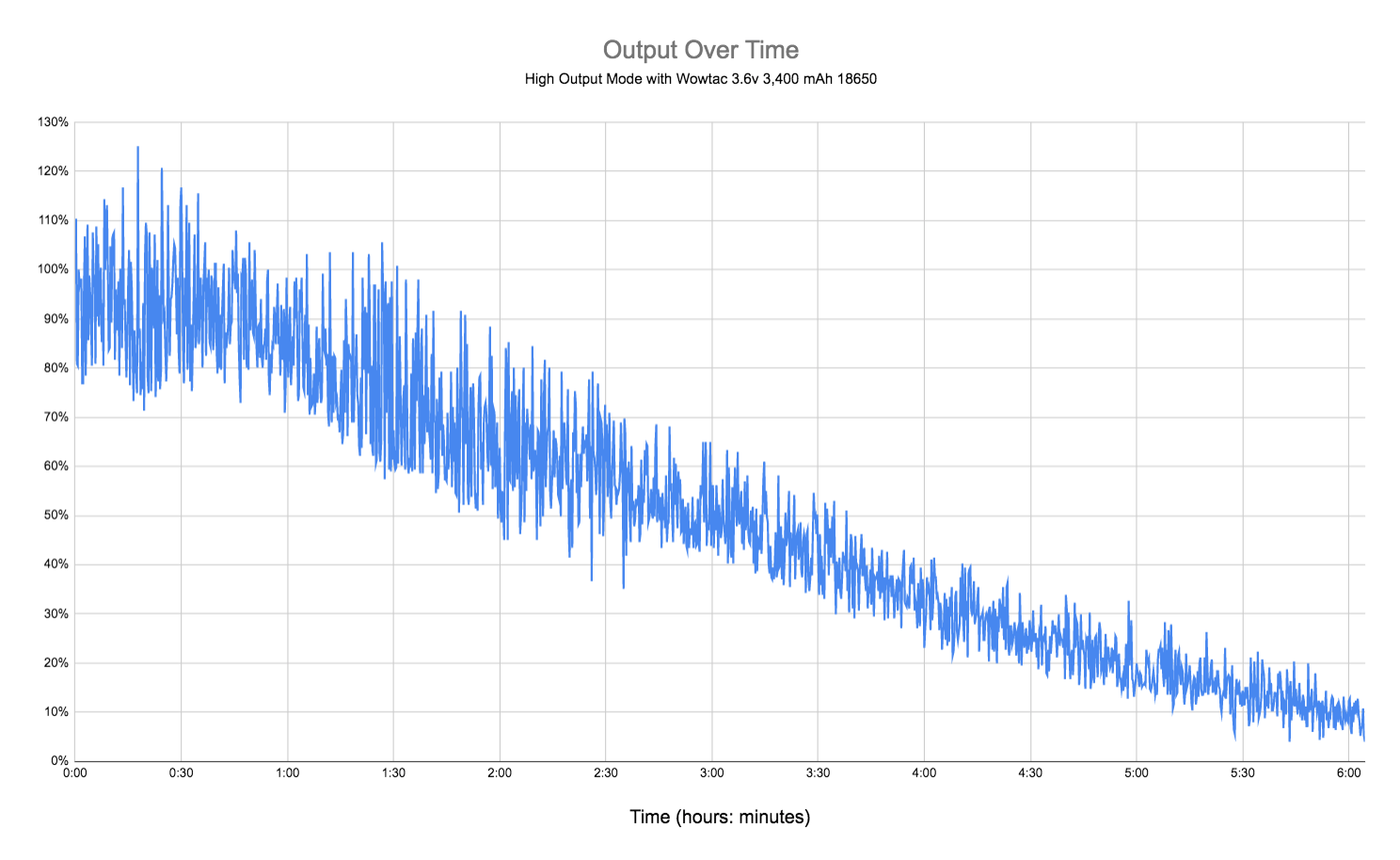
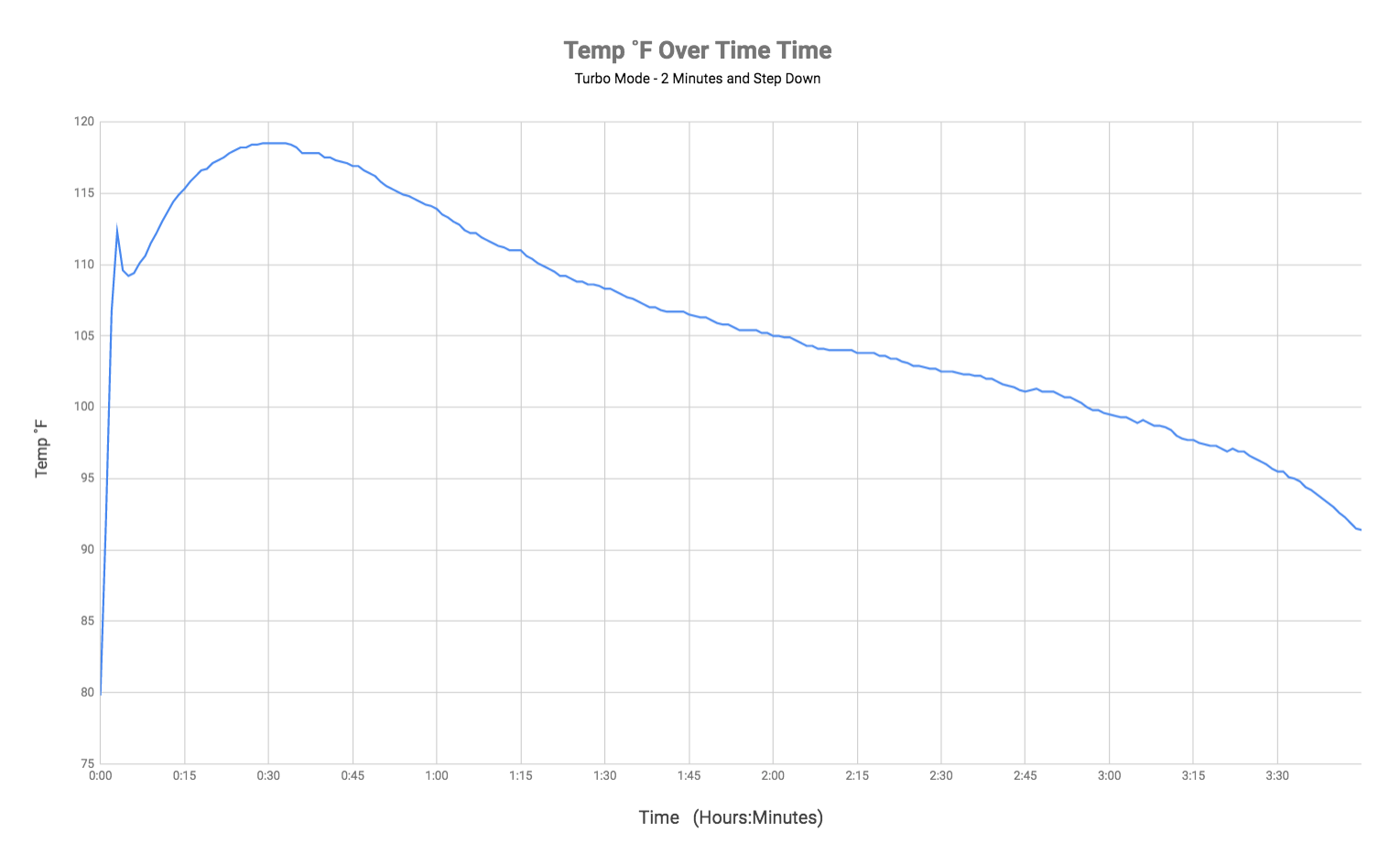
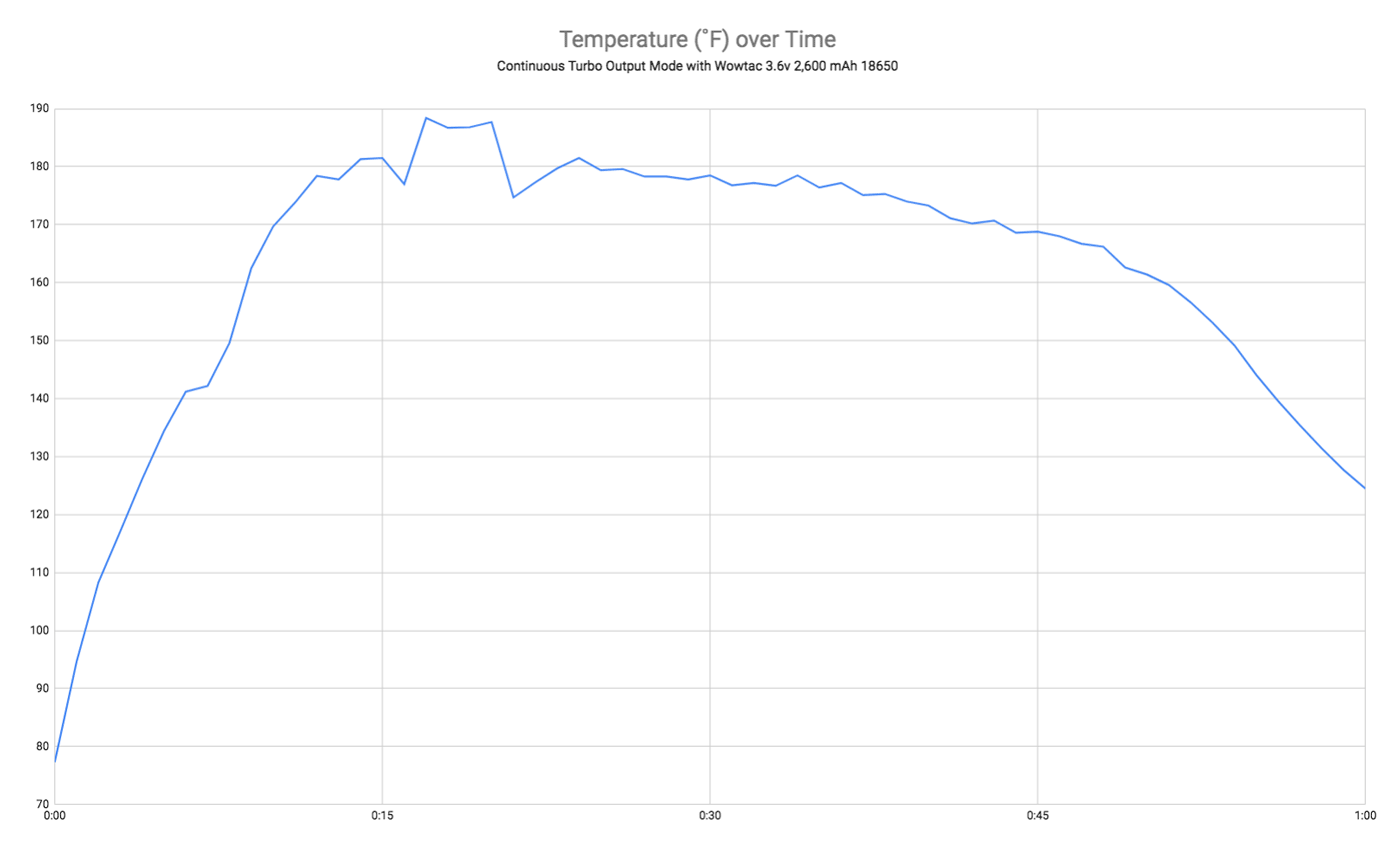
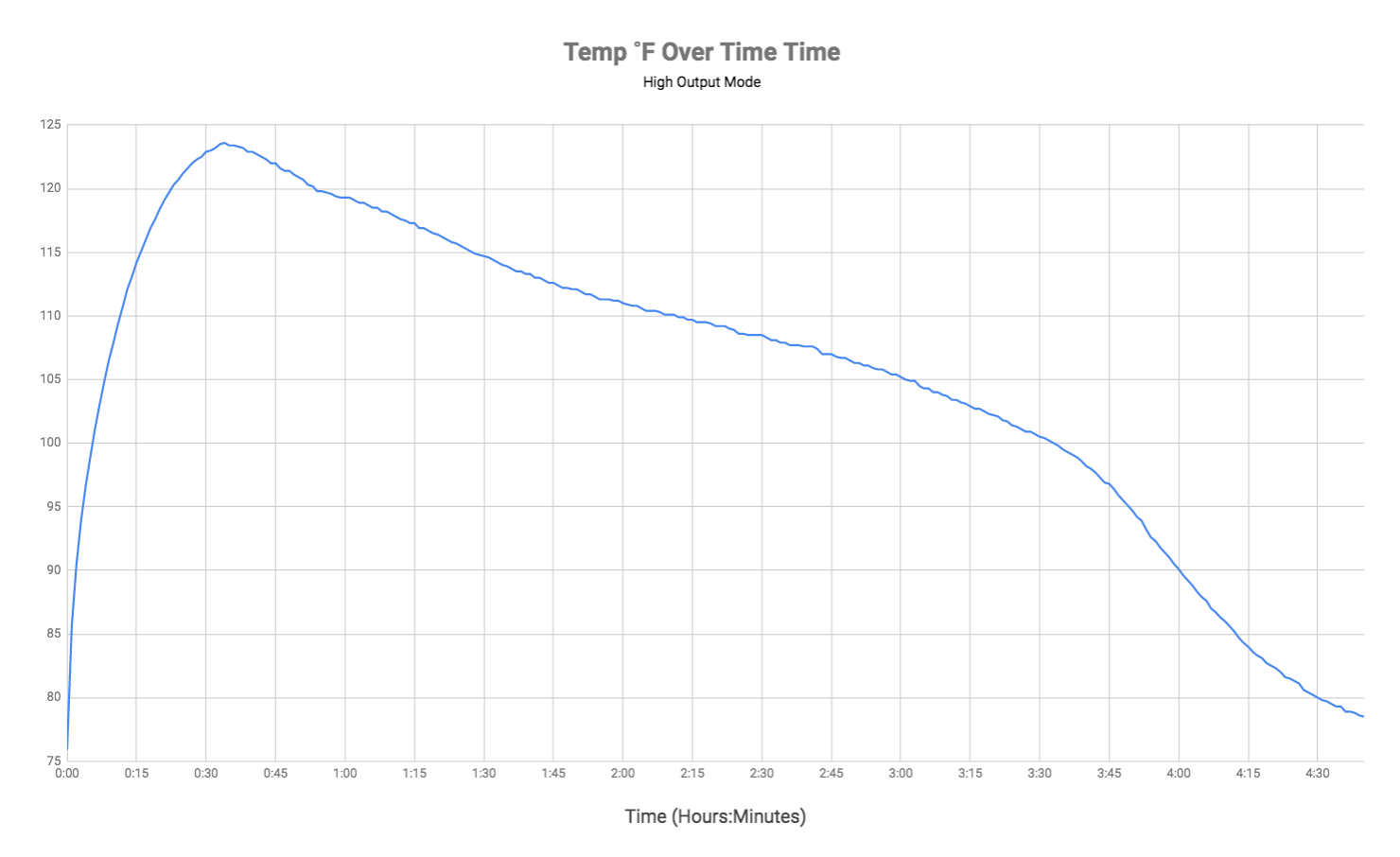
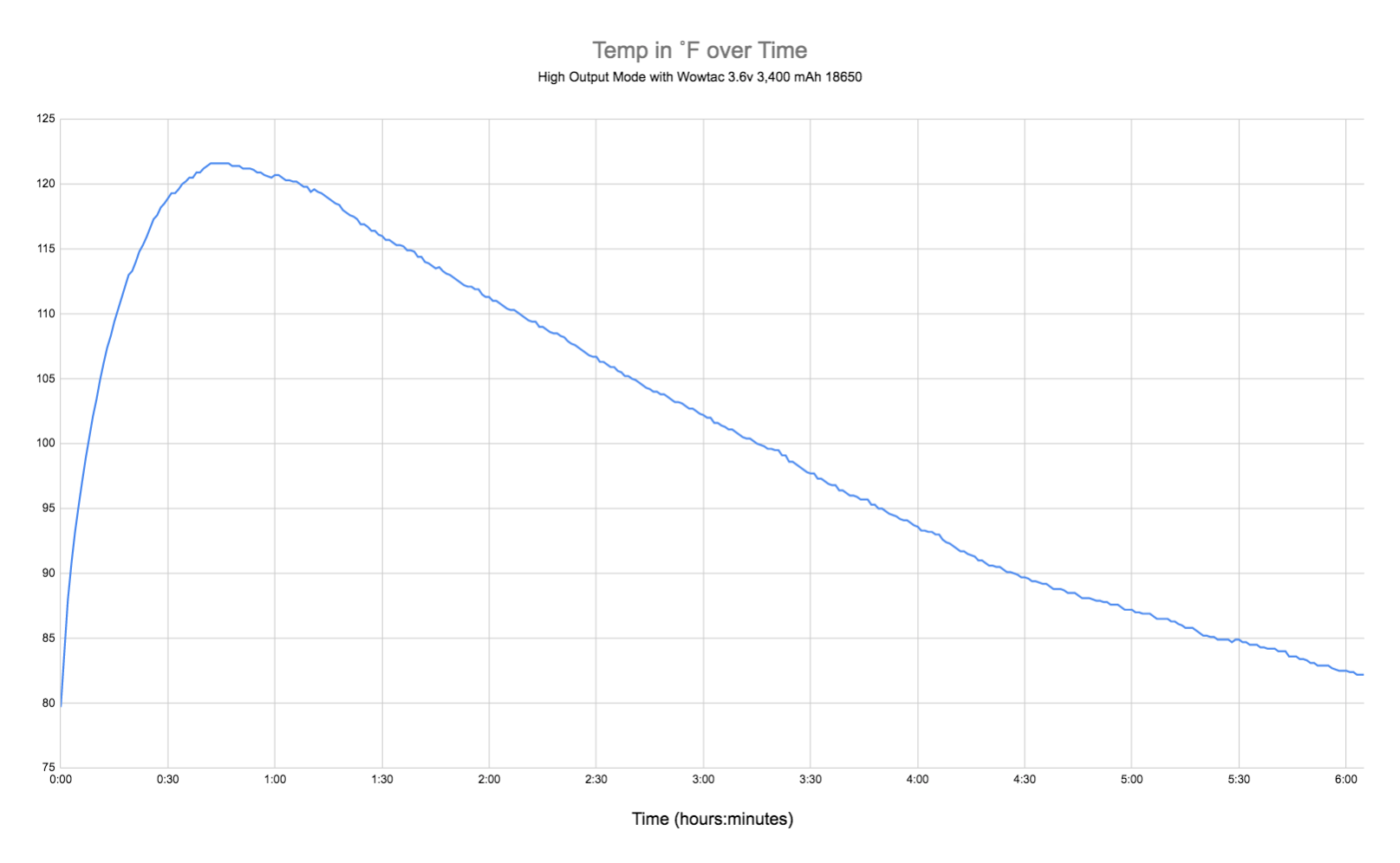
3 replies on “Wowtac A7 Flashlight Review: A Seriously Hot Flashlight”
Thank you for an HONEST flashlight review. All of the youtubers have been sucking up to this company (I guess they got it for free) and saying it is a good flashlight.
More than 200 degrees!!??!! That’s dangerous.
I bought one of these and it’s a really good value flashlight. This is mainly kept in my car. I noticed that the battery that comes with the light is a 2600 MAH 3.6 volts. I have a number of 18650 3400 MAH 3.7 volts. Will these be safe to use in this flashlight.
Hi Richard,
Yes, the 18650 batteries you describe should be safe in that flashlight. I hope this helps.
-Richard